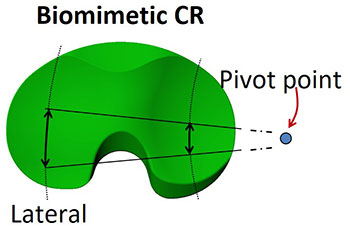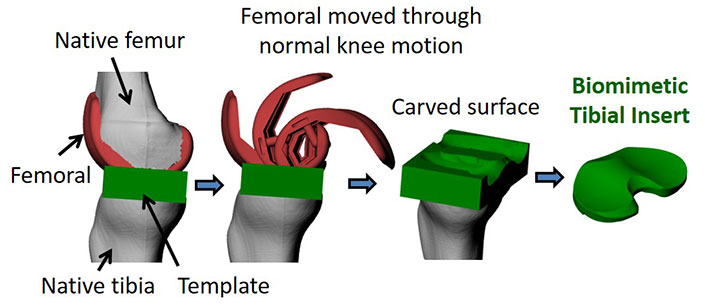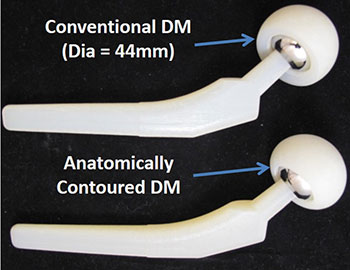Harris Orthopaedics Laboratory: Translational Research
Contact the Harris Orthopaedics Laboratory.
55 Fruit Street
Jackson Building 1206
Boston, MA 02114
Implant Design

Advanced biomechanical simulation tools allow us to predict and analyze performance of various implant designs within the human body. Cadaver studies are used for pre-clinical evaluation of new and existing implant designs. Our lab also hosts a state-of-the-art high resolution 3D printer for rapid prototyping of orthopaedic devices to evaluate their form, fit, and function. Additionally, we have access to various materials characterization tools, heavy duty multi-axis load frames, joint simulators for extended life cycle wear tests, and dedicated cadaver testing facility for pre-clinical evaluations. We also utilize state of the art in vivo imaging techniques (CT, MRI and fluoroscopy) to study in vivo joint mechanics and to create accurate reconstructions of the anatomy for evaluating impact of specific surgical interventions in patients. (MORE INFO)
Capabilities:
Advanced biomechanical simulation tools allow us to predict and analyze performance of various implant designs within the human body. Cadaver studies are used for pre-clinical evaluation of new and existing implant designs. Our lab also hosts a state-of-the-art high resolution 3D printer for rapid prototyping of orthopaedic devices to evaluate their form, fit, and function. Additionally, we have access to various materials characterization tools, heavy duty multi-axis load frames, joint simulators for extended life cycle wear tests, and dedicated cadaver testing facility for pre-clinical evaluations. We also utilize state of the art imaging techniques (CT, MRI and fluoroscopy) to study in vivo joint mechanics and to create accurate reconstructions of the anatomy for evaluating impact of specific surgical interventions in patients.ions of the anatomy for evaluating impact of specific surgical interventions in patients.
Advanced TKA Implant Articular Surfaces:
Although Total Knee Arthroplasty (TKA) procedures have excellent outcomes in terms of long-term implant survivorship and pain relief, 20-30% of patients remain dissatisfied with this procedure due to activity limitations and residual symptoms. This in turn has been linked to limitations of contemporary designs with regards to restoring normal knee motion patterns. To address this we have developed methods for directly using 3D knee motion data collected from healthy individuals to design novel “biomimetic” implant articular surfaces. Computer simulation studies how that by mimicking normal knee anatomy and meniscus function, such designs could aid closer in reproduction of normal knee motion following knee replacement surgery.

Developing Mechanisms to Substitute for Missing ACL in TKA:

The importance of the native ACL in stabilizing the knee joint is well recognized, and its absence following TKA has been linked to abnormal joint motion and perception of instability by patients. However, to date ACL retention has not become part of standard TKA surgical practice, unlike the PCL which is commonly retained. This is because retaining and appropriately balancing both ACL and PCL can be challenging, especially without advanced surgical tools. To address this challenge we are developing novel ACL substituting PCL retaining (ASCR) implants. In these implants the ACL is not retained, instead its function is substituted via interaction between anterior femoral intercondylar notch and an ACL substituting post on the tibial articular surface. With this technology a large number of patients could be benefited without need for specialized tools required to retain the native ACL reliably. Further, patients who present to surgery with an absent or non-functional ACL (due to prior trauma or advanced diseased state) may also be able to obtain improved knee function with such novel implants.
Addressing Soft-Tissue Impingement with Large Diameter Hip Implants:

One of the challenges in Total Hip Arthroplasty (THA) is anterior hip pain resulting from soft-tissue impingement. Our research showed that distal portions of large heads in traditional THA, and mobile liners in dual mobility implants, can impinge on anterior soft-tissues like the iliopsoas. To address this we are developing anatomically contoured large heads and dual mobility liners. Ongoing pre-clinical research shows that these designs can reduce soft-tissue impingement without affecting other important mechanical performance metrics, such as resistance to hip dislocation, wear, pull-out resistance of inner head in dual mobility etc. A biomechanical study showing the efficacy of this design in reducing soft-tissue impingement and liner entrapment in cadaver specimens was recently published. To further analyze the interaction of the new design with native soft-tissues a number of finite element analysis studies are being conducted. Initial results from these studies show that the anatomic liner design may reduce both the mechanical stresses experienced by the soft-tissue, as well the load transfer to the liner rim during engagement with the femoral stem.
